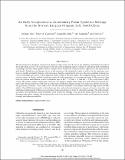Files in this item
An early Neoproterozoic accretionary prism ophiolitic mélange from the western Jiangnan orogenic belt, South China
Item metadata
| dc.contributor.author | Yao, Jinlong | |
| dc.contributor.author | Cawood, Peter A. | |
| dc.contributor.author | Shu, Liangshu | |
| dc.contributor.author | Santosh, M. | |
| dc.contributor.author | Li, Jinyi | |
| dc.date.accessioned | 2017-08-17T00:12:40Z | |
| dc.date.available | 2017-08-17T00:12:40Z | |
| dc.date.issued | 2016-09 | |
| dc.identifier | 246672930 | |
| dc.identifier | 01f7e554-89a0-4fb7-87aa-e60a840b5c44 | |
| dc.identifier | 84988857059 | |
| dc.identifier | 000384691500003 | |
| dc.identifier.citation | Yao , J , Cawood , P A , Shu , L , Santosh , M & Li , J 2016 , ' An early Neoproterozoic accretionary prism ophiolitic mélange from the western Jiangnan orogenic belt, South China ' , The Journal of Geology , vol. 124 , no. 5 , pp. 587-601 . https://doi.org/10.1086/687396 | en |
| dc.identifier.issn | 0022-1376 | |
| dc.identifier.other | RIS: urn:7D6AF6323BE938D4CCA65228CF3CC33C | |
| dc.identifier.uri | https://hdl.handle.net/10023/11493 | |
| dc.description | The authors acknowledge the financial support provided by the National Basic Research Program of China (973 Program, 2012CB416701) and the National Natural Science Foundation of China (41330208 and 41572200). | en |
| dc.description.abstract | The Neoproterozoic Jiangnan orogenic belt delineates the suture zone between the Cathaysia and Yangtze blocks of the South China Craton. The western part of the belt, in the Longsheng region, consists of a disrupted mafic-ultramafic assemblage of pillow basalt, gabbro, diabase, and peridotite along with siliceous marble, ophicalcite, and jasper mixed with basalt. Significant talc deposits occur on the margins of the ultramafic bodies as well as in the transition zone between marble and basalt. Primary rock relations are largely overprinted by pervasive shearing, resulting in disruption of the assemblage into series of discontinuous blocks within a phyllite matrix. West-dipping thrust faults mark the eastern contact of blocks, and the overall succession has the appearance of a tectonic mélange. U-Pb zircon age data from the gabbros and diabases yield crystallization ages of 867 ± 10, 863 ± 8, and 869 ± 9 Ma, with positive εHf(t) values. The gabbro, basalt, serpentinite, and some talc samples display minor light rare earth element?enriched patterns with obvious depletion of Nb and Ta, indicating a subduction-related setting. The tuffaceous phyllite shows similar geochemical features. A few mafic rocks and the altered ultramafic rocks display mid-ocean ridge basalt (MORB) affinity. Overall lithostratigraphic relationships, age data, and geochemical signatures suggest a forearc setting that was imbricated and disrupted within an accretionary prism environment to form an ophiolitic mélange. The pillow basalt, red jasper, and MORB-type mafic-ultramafic rocks within the mélange occur as exotic blocks derived from the subducting oceanic plate, whereas the arc-type mafic rocks occur as autochthonous blocks, which are all exposed in a matrix of sandy and tuffaceous phyllite. | |
| dc.format.extent | 15 | |
| dc.format.extent | 2270145 | |
| dc.language.iso | eng | |
| dc.relation.ispartof | The Journal of Geology | en |
| dc.subject | GE Environmental Sciences | en |
| dc.subject | NDAS | en |
| dc.subject.lcc | GE | en |
| dc.title | An early Neoproterozoic accretionary prism ophiolitic mélange from the western Jiangnan orogenic belt, South China | en |
| dc.type | Journal article | en |
| dc.contributor.institution | University of St Andrews. Earth and Environmental Sciences | en |
| dc.contributor.institution | University of St Andrews. School of Geography and Geosciences | en |
| dc.contributor.institution | University of St Andrews. Scottish Oceans Institute | en |
| dc.contributor.institution | University of St Andrews. St Andrews Isotope Geochemistry | en |
| dc.identifier.doi | https://doi.org/10.1086/687396 | |
| dc.description.status | Peer reviewed | en |
| dc.date.embargoedUntil | 2017-08-16 | |
| dc.identifier.url | http://www.journals.uchicago.edu/doi/suppl/10.1086/687396 | en |
This item appears in the following Collection(s)
Items in the St Andrews Research Repository are protected by copyright, with all rights reserved, unless otherwise indicated.

